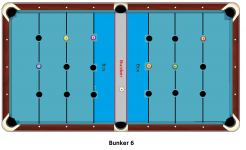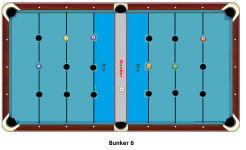orionellis
New member
I created this game as a break from 8 ball, 9 Ball, and drills. It is pretty fun. I have created a youtube and document about Bunker 6. Give it a try.
Please PM me and let me know what you think.
YouTube: Bunker 6
Document: https://skydrive.live.com/redir?resid=B144EDE5E4AE3948%21158
Players:
Unlimited
Balls needed:
Cue ball and colored balls 1-6
Description:
This is a game that emphasizes using the rails and getting the cue call back to the center portion of the pool table after pocketing a ball. It is very similar to 6 Ball.
Terminology:
1. Box – the area (width) between the four diamonds at the center of the pool table.
2. Bunker – the area (width) of the pool table from the edges of one side pocket to the edges of the other side pocket. This area is located at the center of the box.
Racking (positioning the balls at the start of the game):
There is no racking device such as a rack.
There are 6 diamonds on the length of both sides of the pool table and three diamonds on the end and foot rails. There are 6 imaginary lines on the table (3 on both side of the area of the Box). Only one ball can be randomly placed on each of these lines and only where it intersects with the head and foot rail diamonds as seen in the graphic. No balls are to be placed against the rails.
To end any potential confusion about who will rack the ball, both players must place the balls prior to starting a game.
Objective:
After the rack is set, the incoming player has ball in hand (anywhere on the pool table) on the one ball. He or She must send the cue ball to the Box after pocketing the ball. Then balls must be pocketed in order just like in the game of 6 Ball.
Fouls:
1. Scratching
2. Not landing in the Box/ Bunker after legally pocketing a ball.
3. Contacting any ball other than the object ball. The only exception is if after legally pocketing the lowest ball on the table, if the cue ball contacts another ball causing the cue ball to land in the Box/Bunker, this ball is manually replaced back where it was and the shooter continues his or her run.
4. Not legally pocketing the lowest numbered ball on the table.
5. All other fouls from other pocket billiard games.
Landing in the Bunker:
This is highly advantageous for the shooter.
If a shooter’s cue ball lands in the Bunker after legally pocketing a ball, he or she does not have to land in the Box/Bunker upon shooting the very next ball and only for that ball. The shooter can shoot from any position where the ball may land. From the new location, they must land their cue ball back in the Box/Bunker.
Scoring:
To score, the shooter must legally pocket a ball and then they obtain the value of the last legally pocketed ball to reach the Box/Bunker. The values are not added together. For example, if a shooter legally pockets the one through five balls, then the score for that inning is five. The shooter does not have to pocket all six balls.
Racing with other players:
A match has occurred after each player has had an inning. The player with the highest score wins that match. It is possible to tie in a match. For example, after both players have had an inning they could both have the same score.
Please PM me and let me know what you think.
YouTube: Bunker 6
Document: https://skydrive.live.com/redir?resid=B144EDE5E4AE3948%21158
Players:
Unlimited
Balls needed:
Cue ball and colored balls 1-6
Description:
This is a game that emphasizes using the rails and getting the cue call back to the center portion of the pool table after pocketing a ball. It is very similar to 6 Ball.
Terminology:
1. Box – the area (width) between the four diamonds at the center of the pool table.
2. Bunker – the area (width) of the pool table from the edges of one side pocket to the edges of the other side pocket. This area is located at the center of the box.
Racking (positioning the balls at the start of the game):
There is no racking device such as a rack.
There are 6 diamonds on the length of both sides of the pool table and three diamonds on the end and foot rails. There are 6 imaginary lines on the table (3 on both side of the area of the Box). Only one ball can be randomly placed on each of these lines and only where it intersects with the head and foot rail diamonds as seen in the graphic. No balls are to be placed against the rails.
To end any potential confusion about who will rack the ball, both players must place the balls prior to starting a game.
Objective:
After the rack is set, the incoming player has ball in hand (anywhere on the pool table) on the one ball. He or She must send the cue ball to the Box after pocketing the ball. Then balls must be pocketed in order just like in the game of 6 Ball.
Fouls:
1. Scratching
2. Not landing in the Box/ Bunker after legally pocketing a ball.
3. Contacting any ball other than the object ball. The only exception is if after legally pocketing the lowest ball on the table, if the cue ball contacts another ball causing the cue ball to land in the Box/Bunker, this ball is manually replaced back where it was and the shooter continues his or her run.
4. Not legally pocketing the lowest numbered ball on the table.
5. All other fouls from other pocket billiard games.
Landing in the Bunker:
This is highly advantageous for the shooter.
If a shooter’s cue ball lands in the Bunker after legally pocketing a ball, he or she does not have to land in the Box/Bunker upon shooting the very next ball and only for that ball. The shooter can shoot from any position where the ball may land. From the new location, they must land their cue ball back in the Box/Bunker.
Scoring:
To score, the shooter must legally pocket a ball and then they obtain the value of the last legally pocketed ball to reach the Box/Bunker. The values are not added together. For example, if a shooter legally pockets the one through five balls, then the score for that inning is five. The shooter does not have to pocket all six balls.
Racing with other players:
A match has occurred after each player has had an inning. The player with the highest score wins that match. It is possible to tie in a match. For example, after both players have had an inning they could both have the same score.
Last edited:

